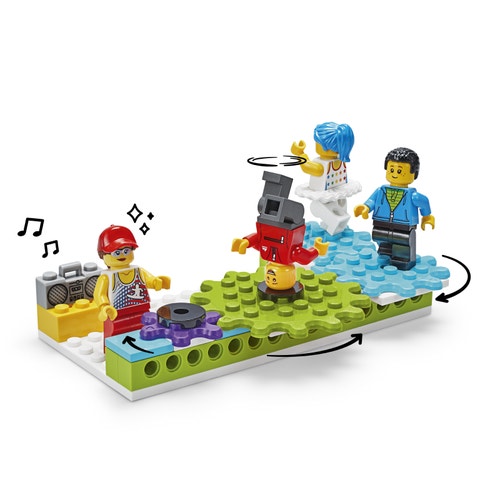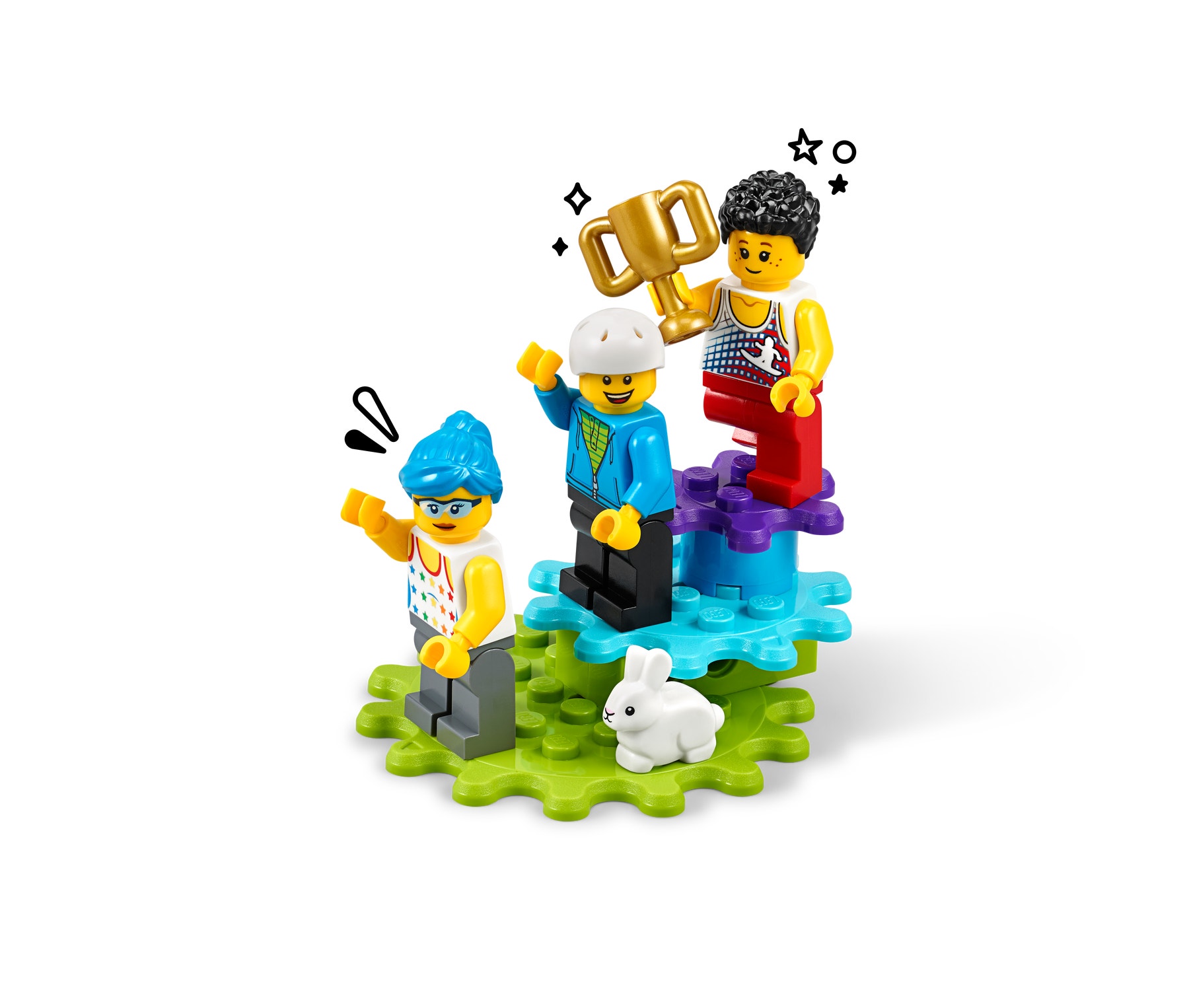Get up and dance!
Get up and dance! Explore how different gears push each other and change the dancers' spinning speed in a fun dance competition.

Prepare
- Review the online pupil material. Use a projector to share this material with your pupils during the lesson.
- Make sure that you have covered the relevant concepts (i.e. push and pull) in an earlier lesson.
- Consider the abilities and backgrounds of all your pupils. Differentiate the lesson to make it accessible to everyone. See the Differentiation section below for suggestions.
Engage
(Whole Class, 10 Minutes)
- Watch the pupil video here or access it via the online pupil material.

- Facilitate a quick discussion about which type of forces can move gears.
- Ask the pupils to describe gears. Use questions like these to facilitate the discussion:
- What do they look like? (e.g. round, with lots of teeth around the edge)
- How do they start turning? (e.g. with force, such as a push)
- Which ways can they turn? (e.g. clockwise, anticlockwise, this way, that way or around)
- Tell the pupils that they’re going to build a moving dance floor with gears, a DJ Minifigure to push the gears, and Minifigure dancers.
- Turn to page 4 in building instructions book ‘A’. Show the page to your pupils and explain what a page number is and why it is important. Point out that the building steps are numbered and that they should be done in order. Explain that each step shows which LEGO® elements are needed and that the number with an ‘x’ shows how many of the pictured element are needed for that step. Quickly flip through the instructions and show the pupils where to stop building.
- Distribute a set to each group.
Explore
(Small Groups, 20 Minutes)
- Have the pupils work in pairs to build the Get Up and Dance model. Tell them to take turns, one partner searching for the bricks while the other builds, switching roles after each step has been done.
- You can find building help in the Tips section below.
- When the pupils have finished building the dance floor, have them design and add Minifigure dancers to the gears.
- Now, have them play ‘freeze dance’.
- Play some dance music.
- Start the movement of the model by pushing the black record on the purple gear (i.e. the DJ's turntable).
- Tell the pupils to stop their dancers when they hear the music stop.
- Stop the music.
- Play the music.
- Repeat several times.
- Have the pupils try spinning the gears in different directions.
- How can they make the gears turn faster or slower?
Explain
(Whole Class, 5 Minutes)
- Gather your pupils together to share what they have built.
- Ask the pupils what they have observed about the movement of the gears. Make sure to cover these points:
- Turning connected gears in different ways causes them to move clockwise or anticlockwise.
- A small gear pushing a big gear makes the big gear move slower (i.e. gearing down).
- A big gear pushing a small gear makes the small gear move faster (i.e. gearing up).
- When you connect two gears of the same size, they move at the same speed.
- In order for two gears to move in the same direction, there must be another gear in the middle. This is called an idling gear.
Elaborate
(Whole Class, 10 Minutes)
- Have your pupils rebuild their dance floors and experiment by moving the gears to different positions.
- If time permits, have the pupils complete the Student Worksheet (Teacher Support – Additional Resources), indicating which are the fast and slow gears.
- Allow 5 minutes for the pupils to disassemble their models, sort the bricks back into the trays and tidy up their workstations.
Evaluate
(Ongoing Throughout the Lesson)
- Ask guiding questions to encourage them to ‘think aloud’ and explain their thought processes and reasoning in the problem-solving decisions they have made when building their models.
Observation Checklist
- Measure your pupils’ proficiency in describing the push forces that are at work in the model.
- Establish a scale that suits your needs. For example:
- Requires additional support
- Can work independently
- Can teach others
Self-Assessment
- Have each pupil choose the brick that they feel best represents their performance.
- Green: I think I can describe what ‘push’ means.
- Blue: I know I can describe what ‘push’ means.
- Purple: I can describe what ‘push’ means, and I can help a friend to understand, too.
Peer Feedback
- In their small groups, have the pupils discuss their experiences working as a group.
- Encourage them to use statements like these:
- I liked it when you…
- I'd like to hear more about when you…

Tips
Model Tips
- Building should not take more than 20 minutes. For groups that have not finished building, pair each pupil with a group that has completed their model.
- The pupils can use the triangles printed on the gears to count the revolutions and help explain why the gear is moving faster or slower.
- When a large gear is pushing a small gear, the pupils can follow the triangles on the small gear to help count how many rotations it moves compared to the large gear.
- Show the pupils how to use the wedge end of the brick separator to pry the gears from their turntables.
Differentiation
Simplify this lesson by:
- Asking the pupils to start by exploring the motion of just one dancer and two gears
Increase the difficulty by:
- Encouraging the pupils to place one Minifigure dancer on a large gear and one on a smaller gear, and then observe the different speeds of each dancer
- Ask questions like these:
- How many times does each dancer turn?
- Which dancer makes more turns?
- How could you create a synchronised dance routine?
- How can you make both dancers move in the same direction?
Extensions
Maths Extension (Note: This will require additional time.)
To incorporate the development of maths skills, have the pupils build on top of the large gears using LEGO® bricks to represent fractional parts. They can do this by counting studs and adding bricks to show a half or a quarter.
National Curriculum Maths ACMNA033
Recognise and interpret common uses of halves, quarters and eighths of shapes and collections
1:1 Hybrid Learning
Download the Personal Learning Kit lesson plan from the hybrid learning resources.
Teacher Support
The pupils will:
- Explore how pushing on an object can change the speed or direction of its motion, and start or stop its movement
- Understand that objects push on one another when they touch and that this can change their motion
- Explore how gears of different sizes push each other, which makes them move faster or slower
- LEGO® Education BricQ Motion Essential Sets (one for every two pupils)
- Dance music (your choice)
National Curriculum
Sc2/1.2
Observing closely, using simple equipment
Sc2/1.3
Performing simple tests
Sc2/1.5
Using their observations and ideas to suggest answers to questions
Sc3/4.2b
Notice that some forces need contact between 2 objects, but magnetic forces can act at a distance
DT1/1.4b
Explore and use mechanisms, in their products
Ma2/2.3d
Solve problems involving multiplication and division, using materials, arrays, repeated addition, mental methods, and multiplication and division facts, including problems in contexts
Ma2/2.4a
Recognise, find, name and write fractions 1/3, 1/4, 2/4 and 3/4 of a length, shape, set of objects or quantity
Ma2/2.4b
Write simple fractions, for example 1/2 of 6 = 3 and recognise the equivalence of 2/4 and 1/2
Ma1/3.1a
Compare, describe and solve practical problems for:
Lengths and heights (for example, long/short, longer/shorter, tall/short, double/half)
Ma1/3.3a
Describe position, directions and movements, including whole, half, quarter and three-quarter turns




